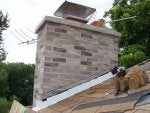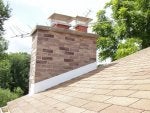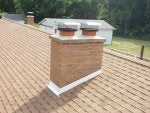I have a family member who wants me to flash around their chimney, which was never done a few years ago when they got a new roof. I don't roof for a living but I feel comfortable doing the repair. My question is after I nail the flashing to the roof do I have to secure it to the brick? If so how do I secure it to the brick. Or will the tar behind the flashing be enough to hold it against the brick. Thanks.

Flashing around a chimney
Barry M
61 - 80 of 219 Posts
Joined
·
156 Posts
I am one for Geocell - had problems keeping license plate light in my old 86 ford due to rust. sealed it up with geocell 6 years ago rust and all still holding - not to mmention my plexiglass window the compressor got shoved through back side 8 years ago still in place. Have'nt had to use it on my 02 chev yet but have a crack in front window maybee?
This is correct, Grumpy, as you know, I like to run my steps up and into the reglet like in the Slater's Handbook. Each course gets a step, and each step is into the reglet. The rear pan is also a single separate piece. I like to lock and solder whenever possible, so that I do not have problems at the corners. :thumbsup:I don't think Aaron said he uses one piece systems. Or did I miss it? I've seen Aaron's metal work with my own eyes and never seen a one piece flashing.
I even think Aaron was the one who previously mentioned the expansion contractoion issues involved with a one piece flashing, or maybe that was Maj.
cut into mortar
i would grind a straight line in the mortar for counterflashing and bond and fill it in with mortar in a tube.
i would grind a straight line in the mortar for counterflashing and bond and fill it in with mortar in a tube.
Joined
·
134 Posts
I agree. This keeps the water from being able to track on to the felt.I agree with some of this post, RRD.
I, however, like to shingle up to the chimney, then install the IWS on top of the lower course. This is done precisely for the condition you stated. You may never need IWS at the chimney, but I do it as a meaure against wind-driven rain.
Joined
·
134 Posts
Not if you install your sealant into the Reglit cut before you install the counter flashing. We use 100% silicone, NEVER laytex.The major issue with the single piece running parallel with the roof edge is this...if you grind through the face of the brick, they can absorb water and spall.
Joined
·
134 Posts
That is the only way we will flash a chimney. We have been doing it this way for 15 years, never had a problem. P.S. Battle Creek, MI "A" Water Tight Roofing Co.Very interesting thread!
A local chimney company uses our services for chimney flashing. They readily admit that their brickies know mortar and brick, but are not as skilled when it comes to metal work and shingles. The brickies' time and resources are better spent doing what they do best. We get to do what we do best.
Our companies refer each other's customers for roofing and chimney services, knowing that in doing so, the customer will get timely, professional and excellent service.
AND . . . . the bonus is another great lead generating machine, which locates pre-qualified buyers. Pretty neat.
For my fellow roofers, a little nugget . . . make friends with your local chimney builder.
We DO "wrap" our chimneys with I/W as a backup to our metal flashing systems.
We do cut the masonry joints, using a classic flashing system.
??? How many of us are snapping a chalk line the length of the chimeny and using one piece flashing instead of the "stepped" counter flashing??
Any challenges with this system? Preferences? Appearance factor?
Just curious.
Andy
Attachments
-
70 KB Views: 12,015
-
61.5 KB Views: 3,803
-
156.6 KB Views: 30,661
Joined
·
134 Posts
Especially.Amazing how quickly the 'know-it-alls' forget that they once performed some given task for the 'first time', too!!
It's not usually the 'questions' that cause the failures, - - but the ANSWERS. :thumbsup:
I agree with Aaron, it is better not to cut your counter through the brick although in some areas it is common. Its better to use a urethene sealant like Dymonic to a colour to match the mortor rather than cheap silicone. It is also critical to make sure you wrap your corners on your base flashing, we usually always use lead but on some high end jobs its a locked and solderd corner. The counterflashing is held in friction fit by lead wedges "but you already knew that". most carperters and masons will screw up flashing work and thats why chimney reflashing is great business.
RooferJim
www.jbennetteroofing.com
RooferJim
www.jbennetteroofing.com
Joined
·
134 Posts
Well Maybe.Especially when you are not allowed to direct them to a site that could help.
Joined
·
134 Posts
It keeps us very busy. There seem to be a variety of methods to flashing a chimney. I like ours best because it is water tight and looks nice.I agree with Aaron, it is better not to cut your counter through the brick although in some areas it is common. Its better to use a urethene sealant like Dymonic to a colour to match the mortor rather than cheap silicone. It is also critical to make sure you wrap your corners on your base flashing, we usually always use lead but on some high end jobs its a locked and solderd corner. The counterflashing is held in friction fit by lead wedges "but you already knew that". most carperters and masons will screw up flashing work and thats why chimney reflashing is great business.
RooferJim
www.jbennetteroofing.com
I'd like to mention that aluminum and the alkalies in mortar are not friends and that the use of aluminum for chimney flashing is not the correct product for that application.
The alkalis present in fresh mortar will attack aluminum. Thus, aluminum should not be used as a flashing material in brick masonry. Also when ever mortar gets wet again it releases these alkalies.
Be sure that any aluminum you use is fully coated with and unbroken protected layer with a product design for resisting these alkali.
The alkalis present in fresh mortar will attack aluminum. Thus, aluminum should not be used as a flashing material in brick masonry. Also when ever mortar gets wet again it releases these alkalies.
Be sure that any aluminum you use is fully coated with and unbroken protected layer with a product design for resisting these alkali.
Joined
·
134 Posts
Use what you want. I could care less what material You use.I'd like to mention that aluminum and the alkalies in mortar are not friends and that the use of aluminum for chimney flashing is not the correct product for that application.
The alkalis present in fresh mortar will attack aluminum. Thus, aluminum should not be used as a flashing material in brick masonry. Also when ever mortar gets wet again it releases these alkalies.
Be sure that any aluminum you use is fully coated with and unbroken protected layer with a product design for resisting these alkali.
Joined
·
134 Posts
It would help if you knew what you were talking about.I'd like to mention that aluminum and the alkalies in mortar are not friends and that the use of aluminum for chimney flashing is not the correct product for that application.
The alkalis present in fresh mortar will attack aluminum. Thus, aluminum should not be used as a flashing material in brick masonry. Also when ever mortar gets wet again it releases these alkalies.
Be sure that any aluminum you use is fully coated with and unbroken protected layer with a product design for resisting these alkali.
As per the building code, alluminum for flashing must be 19 gauge. You had mentioned you use 22 or 24 gauge. This is another example that what you are doing will never pass inspection.
Why not call the building inspector on your next job and post your clearance certificate? That would prove you are correct.:laughing:
Why not call the building inspector on your next job and post your clearance certificate? That would prove you are correct.:laughing:
The Brick Industry Association Technical Note 7A does not recommend using aluminum flashing. It states: "The caustic alkalis present in fresh, unhardened mortar will attack aluminum. Although dry, seasoned mortar will not affect aluminum, corrosion can again occur if the adjacent mortar becomes wet. Aluminum should not be used as a flashing material in brick masonry construction."
That is what I am talking about.
Aluminum flashing is not for chimneys. Do not use it.
I suppose if you can keep the chimney from getting wet you are all set.
That is what I am talking about.
Aluminum flashing is not for chimneys. Do not use it.
I suppose if you can keep the chimney from getting wet you are all set.
Totally agree. I was quoting flashing thickness requirement. So the OP is not using the correct thickness either. His 'bender' probably won't bend the heavier gauge.The Brick Industry Association Technical Note 7A does not recommend using aluminum flashing. It states: "The caustic alkalis present in fresh, unhardened mortar will attack aluminum. Although dry, seasoned mortar will not affect aluminum, corrosion can again occur if the adjacent mortar becomes wet. Aluminum should not be used as a flashing material in brick masonry construction."
That is what I am talking about.
Aluminum flashing is not for chimneys. Do not use it.
I suppose if you can keep the chimney from getting wet you are all set.
http://www.masonrymagazine.com/10-06/chimneysb1.htmlIt would help if you knew what you were talking about.
materials for chimney flashing.
Also in my brick and masonry handbook where ever that might be doesn't suggest the using of galvanized or plated steel, unless it is really thick coating, or especially not aluminum under any circumstances.
Copper, lead or stainless steel are the recommended materials for chimney flashing from my knowledge, so you guys thrilled with your new techniques and ideas about saving time and money are not serving your customers with the best knowledge available unless mortar just started become less alkaline and water stopped coming out of the sky.
I'm not trying to be a wise butt, just trying to keep you abreast of current knowledge as written from a brick layers tech sheet based on the last couple century's of experience from those craftsman. I'm just relaying to you the info.
At least some one knows what I'm talking about.Totally agree. I was quoting flashing thickness requirement. So the OP is not using the correct thickness either. His 'bender' probably won't bend the heavier gauge.
Use what you want. I could care less what material You use.
As one contractor to another; the fact that you did such neat work proves you care.....the fact that you need to be a wise guy before researching my technical info proves I bruised your pride....you do care.
Look up the info in a brick handbook or off the brick and masonry info on the net and you will find the three metals for chimney flashing are lead, copper or stainless steel and that everything else has a limited life expectancy due to the alkali bleeding from mortar.
If you are posting your fine work to be critiqued, and not just to pat yourself on the back, then my critique was to inform...not to cheer lead.
I have heard and read about this, but I have only seen a premature failure once---it was on an old chimney and we used .019. I think that it had the old style combination of mortar/ brick ( one soft one hard-- more lime in the brick?)
Anyway we've been using aluminum, .024 painted for years w/ no issues. I have seen our work from 20 yrs. ago holding up just fine.
Face it, these cheap asphalt shingles don't deserve better flashing (copper) and if I was putting on something that would truly last 30 years or more, I would not use aluminum anyway
Anyway we've been using aluminum, .024 painted for years w/ no issues. I have seen our work from 20 yrs. ago holding up just fine.
Face it, these cheap asphalt shingles don't deserve better flashing (copper) and if I was putting on something that would truly last 30 years or more, I would not use aluminum anyway
61 - 80 of 219 Posts
-
?
-
?
-
?
-
?
-
?
-
?
-
?
-
?
-
?
-
?
-
?
-
?
-
?
-
?
-
?
-
?
-
?
-
?
-
?
-
?
- posts
- 3.6M
- members
- 169K
- Since
- 2003
A forum community dedicated to professional construction and remodeling contractors. Come join the discussion about the industry, trades, safety, projects, finishing, tools, machinery, styles, scales, reviews, accessories, classifieds, and more!
Explore Our Forums






